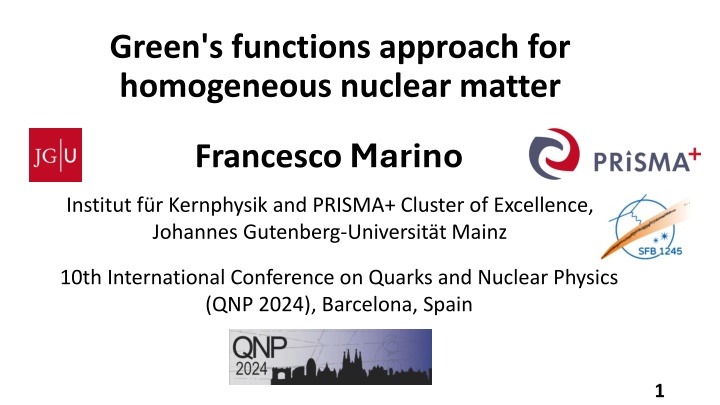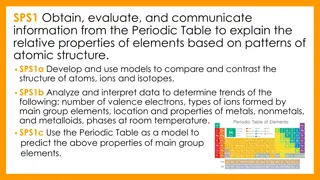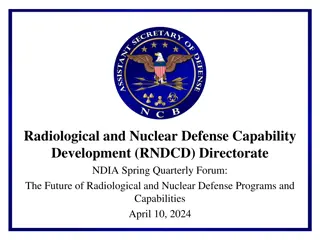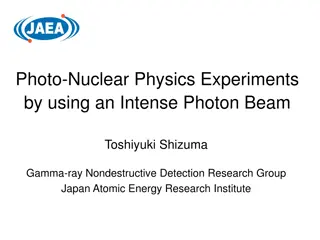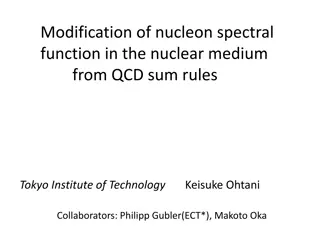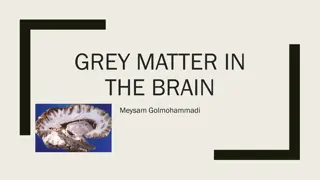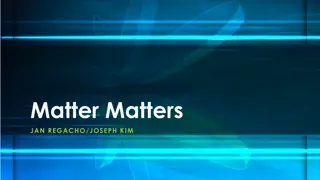Advanced Studies on Nuclear Matter Using Green's Functions Approach
Francesco Marino presents research on the Green's functions approach for homogeneous nuclear matter at the 10th International Conference on Quarks and Nuclear Physics. The ab initio approach in nuclear theory, self-consistent Green's functions, and algebraic diagrammatic construction are explored. Pairing correlations and Gorkov theory for superfluid systems are also discussed, providing insights into the properties and behavior of nuclear matter.
Download Presentation

Please find below an Image/Link to download the presentation.
The content on the website is provided AS IS for your information and personal use only. It may not be sold, licensed, or shared on other websites without obtaining consent from the author.If you encounter any issues during the download, it is possible that the publisher has removed the file from their server.
You are allowed to download the files provided on this website for personal or commercial use, subject to the condition that they are used lawfully. All files are the property of their respective owners.
The content on the website is provided AS IS for your information and personal use only. It may not be sold, licensed, or shared on other websites without obtaining consent from the author.
E N D
Presentation Transcript
Green's functions approach for homogeneous nuclear matter Francesco Marino Institut f r Kernphysik and PRISMA+ Cluster of Excellence, Johannes Gutenberg-Universit t Mainz 10th International Conference on Quarks and Nuclear Physics (QNP 2024), Barcelona, Spain 1
Ab initio approach Ab initio nuclear theory = Nucleons as degrees of freedom Realistic model of the nuclear interaction Systematically improvable many-body method Systematically improvable many-body method Ekstr m, Phys. Rev. C 97, 024332 (2018) Predictions with controlled uncertainties 2 Francesco Marino Barcelona, 10 July 2024
Overview Infinite nuclear matter withself- consistent Green s functions Electromagnetic response of open-shell nuclei with coupled-cluster 2 Francesco Marino Barcelona, 10 July 2024
Part 1: Green s functions for infinite nuclear matter 4 Francesco Marino Barcelona, 10 July 2024
Self-consistent Greens functions ?(?) = ?(0)? + ? ? (?)?(0)? Dyson equation Self-energy Propagator ?(?) gives access to the total energy and one-body observables Equation of state Momentum distribution PNM PNM SNM Barbieri, Lect. Notes Phys. 936, 571 (2017) Som , Front. Phys. 8, 340 (2020) 5 Francesco Marino Barcelona, 10 July 2024
Algebraic diagrammatic construction = ( )+ (?) = ? ? Self-consistent GF Static self-energy Dynamical self-energy ADC(3) ADC(2) Algebraic diagrammatic construction (ADC) Ring ADC(3) includes third-order perturbation theory, ladders, rings Ladder Raimondi, Phys Rev C 97, 054308 (2018) Barbieri, Phys. Rev. C 105, 044330 (2022) 6 Francesco Marino Barcelona, 10 July 2024
Pairing correlations In collaboration with Carlo Barbieri and Gianluca Col (Milano) Gorkovtheory = Green s functions for superfluid systems + ADC(3) dynamical self-energy First-order pairing corrections Anomalous self-energy Dyson matrix Chemical potential 12( ) (? ?1) ?(?)?? ?? ?? ?? ?? ? ?1 12( ) = = ?? ?? Som , Phys. Rev. C 84, 064317 (2011) 7 Francesco Marino Barcelona, 10 July 2024
Coupled-cluster 0 = ??| 0 Coupled-cluster (CC) ansatz ? = ? ?? n-particle n-hole amplitudes | 0 = + | 0 2?2 excitations CCD: CCD(T): truncate at doubles (2p2h) level triples (3p3h) corrections ?2= Hagen, Rep. Prog. Phys. 77, 096302 (2014) 8 Hagen, Phys. Rev. C 89, 014319 (2014) Francesco Marino Barcelona, 10 July 2024
ADC + coupled-cluster amplitudes ADC(3)-D Ad hoc extension of ADC(3) ?? ? ??? ??+ ?? ?? ?? ?? = (?0)?? In (?), replace ?(0) with converged CCD amplitudes ???? ?0 Barbieri, Lect. Notes Phys. 936, 571 (2017) Hodecker, J. Chem. Phys. 150, 174104 (2019) 9 Francesco Marino Barcelona, 10 July 2024
Equation of state - SCGF and coupled-cluster In collaboration with ` Weiguang Jiang (Mainz) ADC(3) Correlation energy ?????= ? ??? ADC(3)-D Sam Novario (St. Louis) CCD(T) Pure neutron matter Symmetric nuclear matter EOS 10 Francesco Marino Barcelona, 10 July 2024
Saturation point of symmetric nuclear matter Empirical saturation point Linear correlation between saturation density and energy 11 Francesco Marino Barcelona, 10 July 2024
Momentum distributions Discontinuity at the Fermi surface High-momentum tail Preliminary! 12 Francesco Marino Barcelona, 10 July 2024
Spectral functions neutron matter Spectral function Quasiparticle 2?(? ??) ? ?,? = ?? ? Fragmentation Fermi energy 13 Francesco Marino Barcelona, 10 July 2024
Part 2: Ab initio electromagnetic response of open-shell nuclei with coupled-cluster 14 Francesco Marino Barcelona, 10 July 2024
Ab initio electromagnetic response Electromagnetic reactions are a powerful tool to probe the structure of nuclei 2?(?? ?0 ?) ? ? = ? 0 Challenges for ab initio ? Coupled-cluster (CC) Scale up in mass Hagen, Rep. Prog. Phys. 77, 096302 (2014) Lorentz integral transform (LIT) Continuum Continuum Bacca, Phys. Rev. C 90, 064619 (2014) Two-particle-attached/ removed (2PA/2PR) Open-shell nuclei Bonaiti, arXiv: 2405.05608 (2024) 15 Francesco Marino Barcelona, 10 July 2024
Two-particle-removed coupled-cluster ? 2 = ?(? 2) 0 A-2 open-shell nucleus ? Closed-shell nucleus 0 = ??| 0 One-particle three-hole (1p3h) Two-hole (0p2h) 1 2 1 6 ???? ?????? ??? ?(? 2)= ??????? + ???? ?? 16 Francesco Marino Barcelona, 10 July 2024
Eletric dipole polarizability 1 ??= 2 ???(?) ? Strong linear correlation between ?? and the slope of the symmetry energy L Constraints on the neutron matter EOS from the electric dipole response Roca-Maza, Phys. Rev. C 88, 024316 (2013) 17 Francesco Marino Barcelona, 10 July 2024
Eletric dipole polarizability 2 ??= 2 ???(?) ? In collaboration with ` Sonia Bacca, Francesca Bonaiti (Mainz) Accessible to 2PR Gaute Hagen, Gustav Jansen (Oak Ridge) Closed-shell Two-particle-attached (2PA) Two-particle-removed (2PR) Two-particle- removed 18 Francesco Marino Barcelona, 10 July 2024
Conclusions and perspectives Part 1 The ADC(3) Green s functions method is a powerful ab initio tool to study the EOS and single- particle properties of nuclear matter Applications: low-density neutron matter, quasi-particle properties, dynamical response Part 2 The ab initio coupled-cluster + Lorentz integral transform (LIT-CC) technique is used to study the electric dipole response in open-shell nuclei Ongoing: dipole polarizability of two-particle-removed nuclei Prospects: one-particle-attached/removed, monopole response 19 Francesco Marino Barcelona, 10 July 2024
Thank you for your attention! Collaborators Mainz: Sonia Bacca, Francesca Bonaiti, Weiguang Jiang Milano: Carlo Barbieri, Gianluca Col Oak Ridge: Gaute Hagen, Gustav Jansen St. Louis: Sam Novario 20 Francesco Marino Barcelona, 10 July 2024
Spectral functions symmetric matter Periodic boundary conditions Twist-averaged boundary conditions Particle peaks Mixed particle - hole character Hole peaks SNM, ?0= 0.16 fm-3 ,A=132, NNLOsat 21 Francesco Marino Barcelona, 10 July 2024
Lorentz integral transform 2?(?? ?0 ?) ? ? = ? 0 Response function ? ??? = ? ?2+ 2= ?(?) ? ?? ? ?| ? Lorentz integral transform ? is solution to the bound-state equation with source term ? ?0 ? ? ? = 0 ? = ? ???? Similarity-transformed Hamiltonian T: ground state CC amplitudes Equations-of-motion ansatz ? = ?(?) 0 22 Francesco Marino Barcelona, 10 July 2024
Eletric dipole polarizability DFT data from: Roca-Maza, Phys. Rev. C 88, 024316 (2013) Ab initio data from: Hu, Nat. Phys. 18, 1196-1200 (2022) Courtesy: Francesca Bonaiti 23 Francesco Marino Barcelona, 10 July 2024
Equations of state 24 Francesco Marino Barcelona, 10 July 2024
Non-skeleton corrections Static self-energies fully iterated. Dynamical terms optimized reference state (OpRS) When full self-consistency is dropped, additional non-skeleton diagrams External potential correcting for using an optimized state instead of HF ?(1)= ??? ?(????) Raimondi, Phys Rev C 97, 054308 (2018) In the following, results for ADC(3) and ADC(3) with non-skeleton corrections 25 Francesco Marino Barcelona, 10 July 2024
Self-consistent Greens functions Equation of state ?(?) = ?(0)? + ? ? (?)?(0)? Dyson equation PNM Self-energy Propagator ?(?) gives access to one-body observables and the total energy SNM 1 ?(0)(?,?) = Reference propagator Momentum distribution ? ???(?) 2 ?? ?(?,?) = Full propagator PNM ? ??(?) ? Spectral representation Som , Front. Phys. 8, 340 (2020) Barbieri, Lect. Notes Phys. 936, 571 (2017) 26 Francesco Marino Barcelona, 10 July 2024
